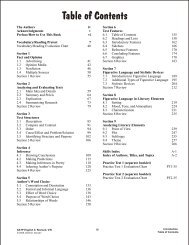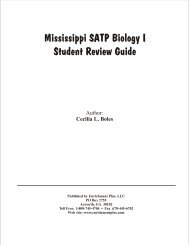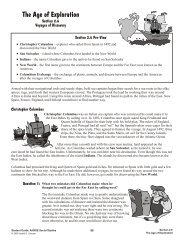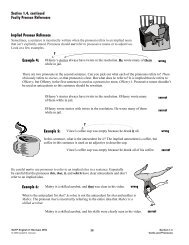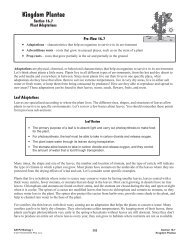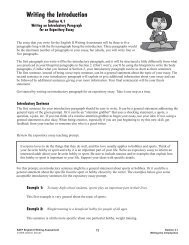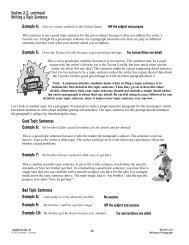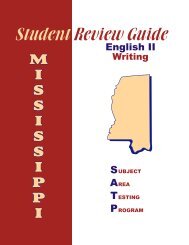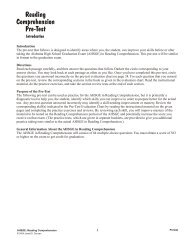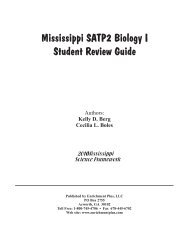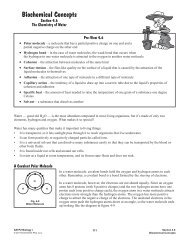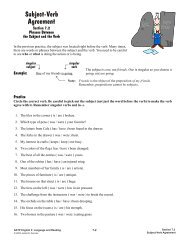Biology Pre-Test - Enrichment Plus
Biology Pre-Test - Enrichment Plus
Biology Pre-Test - Enrichment Plus
Create successful ePaper yourself
Turn your PDF publications into a flip-book with our unique Google optimized e-Paper software.
<strong>Biology</strong><br />
<strong>Pre</strong>-<strong>Test</strong><br />
Introduction<br />
Introduction<br />
The pre-test that follows is designed to identify areas where you, the student, can improve your skills before or after<br />
taking the Alabama High School Graduation Exam (AHSGE) in Science.<br />
Directions<br />
Read each question carefully and darken the circle corresponding to your answer choice. Once you have completed<br />
this pre-test, circle the questions you answered incorrectly on the pre-test evaluation chart on page 26. For each<br />
question that you missed on the pre-test, review the corresponding sections in the book as given in the evaluation<br />
chart. Read the instructional material, do the practice exercises, and take the section review test at the end of each<br />
section.<br />
Purpose of the <strong>Pre</strong>-<strong>Test</strong><br />
The following pre-test can be used as practice for the AHSGE in Science, but it is primarily a diagnostic tool to help<br />
you identify which skills you can improve in order to prepare better for the actual test. Any pre-test question answered<br />
incorrectly may identify a skill needing improvement or mastery. Review the corresponding skill(s) indicated in the<br />
<strong>Pre</strong>-<strong>Test</strong> Evaluation Chart by reading the instructional material on the given pages and completing the practice<br />
exercises and reviews. By reviewing each skill, you will improve mastery of the material to be tested on the Science<br />
portion of the AHSGE and potentially increase the score you receive on that exam. (The practice tests, which are<br />
given in separate booklets, are provided to give you additional practice taking tests similar to the actual AHSGE in<br />
Science.)<br />
General Information About the AHSGE in Science<br />
The AHSGE in Science will consist of 100 multiple-choice questions. You must obtain a score of 491 or higher on the<br />
exam to pass.<br />
AHSGE: <strong>Biology</strong><br />
© 2008 Jerald D. Duncan<br />
7<br />
<strong>Pre</strong>-<strong>Test</strong>
<strong>Biology</strong> <strong>Pre</strong>-<strong>Test</strong><br />
9. A cell moves glucose across its cell membrane<br />
from an area of lower concentration to an area<br />
of higher concentration by expending energy to<br />
do so. This movement is an example of<br />
A<br />
B<br />
C<br />
D<br />
osmosis.<br />
active transport.<br />
diffusion.<br />
passive transport.<br />
A B C D<br />
13. Study the diagram below.<br />
cellular<br />
membrane [<br />
Higher Concentration of Oxygen<br />
O 2 O 2 O 2<br />
O<br />
O O 2<br />
2 2 O 2<br />
O 2 O<br />
O 2 2<br />
Lower Concentration of Oxygen<br />
10.<br />
The cell membrane is made primarily of<br />
The movement of oxygen as diagramed above is<br />
an example of<br />
A<br />
B<br />
C<br />
D<br />
phospholipids.<br />
nucleic acids.<br />
carbohydrates.<br />
water.<br />
A<br />
B<br />
C<br />
D<br />
osmosis.<br />
active transport.<br />
diffusion.<br />
photosynthesis.<br />
A B C D<br />
A B C D<br />
11.<br />
Which of the following is the main function of<br />
nucleic acids in cells?<br />
14.<br />
Which of the following is NOT a function of<br />
protein?<br />
A<br />
B<br />
C<br />
D<br />
to create ATP<br />
to store genetic information<br />
to store long-term energy<br />
to form structural components of the body<br />
A<br />
B<br />
C<br />
D<br />
forming the main component of muscle<br />
forming enzymes<br />
storing and transporting substances<br />
storing and passing on genetic information<br />
A B C D<br />
A B C D<br />
12.<br />
The concentration of CO 2 (carbon dioxide)<br />
must be maintained within a narrow range in<br />
the blood of most mammals. Maintaining the<br />
correct concentration of CO 2 in the blood is an<br />
example of<br />
A<br />
B<br />
C<br />
D<br />
excretion.<br />
glycolysis.<br />
homeostasis.<br />
transpiration.<br />
A B C D<br />
15. A plant that normally grows near a freshwater<br />
pond is transplanted near a saltwater marsh.<br />
What will MOST likely happen to the plant?<br />
A<br />
B<br />
C<br />
D<br />
Its cells will gain turgor pressure.<br />
The plant will wilt and possibly die.<br />
Its cells will burst.<br />
The plant will experience no change.<br />
A B C D<br />
AHSGE: <strong>Biology</strong><br />
© 2008 Jerald D. Duncan<br />
10<br />
<strong>Pre</strong>-<strong>Test</strong>
<strong>Biology</strong> <strong>Pre</strong>-<strong>Test</strong><br />
39. Look at the pedigree graphic below.<br />
42. If a certain trait is present even if only one allele<br />
for that trait is present, that trait is said to be<br />
A<br />
B<br />
C<br />
D<br />
a sex-linked trait.<br />
a pedigree trait.<br />
a dominant trait.<br />
a recessive trait.<br />
A B C D<br />
This pedigree shows that only males are affected<br />
by a certain disorder. What type of inheritance<br />
is indicated by the pedigree?<br />
43. Which of the following would be the LEAST<br />
likely to cause birth defects in offspring?<br />
A<br />
recessive<br />
A<br />
repeated exposure to x-rays<br />
B<br />
dominant<br />
B<br />
prolonged skin contact with pesticides<br />
C<br />
incomplete<br />
C<br />
losing a limb in an industrial accident<br />
D<br />
sex-linked<br />
D<br />
breathing second-hand tobacco smoke<br />
A B C D<br />
A B C D<br />
40. Certain breeds of cattle have a gene for red hair<br />
and a gene for white hair. If a white bull is<br />
crossed with a red cow, the offspring will have<br />
roan hair. Roan is a combination of some red<br />
and some white. The genes that cause roan hair<br />
color are an example of<br />
A<br />
B<br />
C<br />
D<br />
incomplete dominance.<br />
codominance.<br />
recessive.<br />
homozygous dominance.<br />
44. What is the function of messenger RNA?<br />
A<br />
B<br />
C<br />
D<br />
to transfer the code from the DNA in the<br />
nucleus to the cytoplasm<br />
to store and pass on genetic information<br />
to assist in building proteins by adding amino<br />
acids in the ribosome<br />
to create the energy needed for cellular<br />
processes<br />
A B C D<br />
A B C D<br />
41. The trait for brown eyes (B) in humans is<br />
dominant to blue eyes (b). Two parents with<br />
brown eyes have a child with blue eyes. What<br />
can you conclude about the genotypes of the<br />
parents?<br />
A<br />
B<br />
C<br />
D<br />
Both parents are heterozygous for eye color.<br />
One parent is homozygous for brown eyes, and<br />
the other parent is heterozygous.<br />
Both parents are homozygous for brown eyes.<br />
One parent is homozygous for brown eyes, and<br />
the other parent is homozygous for blue eyes.<br />
A B C D<br />
45.<br />
A chemical company that produces a weed<br />
killing chemical also produces a genetically<br />
modified corn plant that is not harmed by the<br />
weed killer. The company created the new corn<br />
plant by adding an herbicide resistant gene.<br />
These new corn plants are examples of<br />
A<br />
B<br />
C<br />
D<br />
plasmids.<br />
transgenic organisms.<br />
transformations.<br />
recombinants.<br />
A B C D<br />
AHSGE: <strong>Biology</strong><br />
© 2008 Jerald D. Duncan<br />
15<br />
<strong>Pre</strong>-<strong>Test</strong>
<strong>Biology</strong><br />
<strong>Pre</strong>-<strong>Test</strong><br />
Evaluation Chart<br />
If you missed<br />
question #:<br />
Go to<br />
section(s):<br />
If you missed<br />
question #:<br />
Go to<br />
section(s):<br />
If you missed<br />
question #:<br />
Go to<br />
section(s):<br />
1<br />
2<br />
3<br />
4<br />
5<br />
6<br />
7<br />
8<br />
9<br />
10<br />
11<br />
12<br />
13<br />
14<br />
15<br />
16<br />
17<br />
18<br />
19<br />
20<br />
21<br />
22<br />
23<br />
24<br />
25<br />
26<br />
27<br />
28<br />
29<br />
30<br />
31<br />
32<br />
33<br />
34<br />
1.1, 1.3, 2.2<br />
3.1<br />
3.1<br />
1.1, 1.3<br />
2.3, 2.4<br />
3.1, 3.2<br />
3.1, 3.2<br />
2.1, 2.3, 2.4, 5.2<br />
7.1, 7.2, 7.3, 7.4<br />
6.3, 7.1<br />
6.5<br />
7.1, 7.5<br />
7.1, 7.2<br />
6.4, 6.6<br />
7.3<br />
7.3<br />
7.6<br />
6.6<br />
7.5<br />
8.3, 8.5<br />
8.1, 8.2<br />
5.4, 5.5<br />
5.4<br />
5.3, 5.4<br />
5.1<br />
5.3, 13.3, 14.1<br />
5.2<br />
5.6<br />
22.1<br />
5.6<br />
9.1<br />
9.2<br />
9.4<br />
9.2<br />
35<br />
36<br />
37<br />
38<br />
39<br />
40<br />
41<br />
42<br />
43<br />
44<br />
45<br />
46<br />
47<br />
48<br />
49<br />
50<br />
51<br />
52<br />
53<br />
54<br />
55<br />
56<br />
57<br />
58<br />
59<br />
60<br />
61<br />
62<br />
63<br />
64<br />
65<br />
66<br />
67<br />
68<br />
9.2, 9.3<br />
10.1, 10.2<br />
10.1, 10.2<br />
10.1, 10.2<br />
10.3, 11.4<br />
11.2<br />
10.1, 10.2<br />
10.1<br />
12.4<br />
12.3<br />
12.5<br />
12.1, 12.2<br />
12.5<br />
12.3, 12.4<br />
12.1<br />
9.2<br />
20.2<br />
10.1, 10.2, 10.3<br />
10.1, 10.2, 11.3<br />
8.3, 13.3, 14.1, 14.2, 15.1<br />
14.1, 14.3<br />
13.4<br />
13.3<br />
13.2<br />
13.1<br />
13.1<br />
13.1<br />
15.1, 15.2, 15.3<br />
15.1, 15.4, 15.5<br />
15.3<br />
16.2<br />
15.6<br />
15.5<br />
16.2, 16.4<br />
69<br />
70<br />
71<br />
72<br />
73<br />
74<br />
75<br />
76<br />
77<br />
78<br />
79<br />
80<br />
81<br />
82<br />
83<br />
84<br />
85<br />
86<br />
87<br />
88<br />
89<br />
90<br />
91<br />
92<br />
93<br />
94<br />
95<br />
96<br />
97<br />
98<br />
99<br />
100<br />
17.3<br />
17.5<br />
17.1, 17.3, 17.5, 18.2, 18.3<br />
18.3<br />
17.2<br />
18.4<br />
20.1, 20.2<br />
18.4<br />
17.4, 18.4<br />
18.3<br />
20.2<br />
22.3, 22.4<br />
22.1, 22.5<br />
22.3<br />
13.3, 15.1<br />
5.5, 13.3<br />
22.4<br />
22.3<br />
22.1, 22.5<br />
23.4<br />
21.4<br />
21.2<br />
22.2, 22.5<br />
23.3<br />
23.4<br />
21.1<br />
23.1<br />
23.1<br />
22.2<br />
22.2<br />
23.2<br />
22.6<br />
AHSGE: <strong>Biology</strong><br />
© 2008 Jerald D. Duncan<br />
26<br />
<strong>Pre</strong>-<strong>Test</strong>



